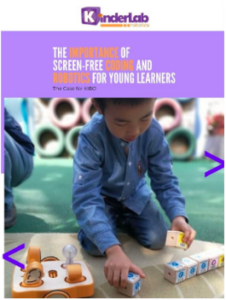THE Journal: STEM Tools, Games and Products to Engage Girls in Pre-K Through Early Elementary School
In this article, Dr. Amanda Sullivan, Ph.D., a chief researcher of KIBO, provides educators with examples of tools, games and products that can be used with girls as early as preschool to practice foundational STEM skills.
Amanda received her Master’s and Ph.D. in Child Development at Tufts University in the Eliot-Pearson Department of Child Study and Human Development, where she worked on the research and development of the KIBO robot with the DevTech Research Group. Her research centers on engaging girls in STEM and understanding young children’s development of gender stereotypes toward the technical STEM fields. Amanda is now a Lecturer in the Early Childhood Technology Graduate Certificate Program at Tufts and a research consultant with DevTech. Follow Amanda on Twitter @AASully.
Learn more about her research in her book, Breaking the STEM Stereotype: Reaching Girls in Early Childhood.
Some of Amanda’s recommendations for STEM games, tools and products for girls:
1) Provide girls with tools that allow them to tinker, build, practice spatial reasoning and engineer (examples: blocks, LEGOs, Duplos, recycled materials).
2) Provide girls with tools that engage them in computer science related play (examples: programming apps and programmable robotics kits).
3) Provide girls with tools that allow them to work or play with other children (examples: STEM board games and tangible building and robotics kits).
4) Provide girls with tools and toys that work with their hobbies and interests, whether they come from the pink aisle, blue aisle, or any other aisle! If you are worried that the packaging/marketing of a toy will make girls shy away, then toss the box before you offer them the toy!
About KIBO
Programmable robotics kits offer a hands-on introduction to building, engineering and coding. Hands-on tinkering and building is something often missing from the play young girls engage in. Providing tangible robotics materials can give girls an opportunity to engage in open-ended tinkering and exploring. As an added bonus, many newer robotics kits for young children are programmed with completely screen-free interfaces!
When looking for a robotics kit that will engage young girls in both building and programming, kits like the KIBO Robot Kit offer the best of both worlds. KIBO is a robotics kit designed to playfully introduce young children (ages 4–7 years) to foundational engineering and programming concepts through tangible screen-free activities. KIBO was created based on research by Professor Bers and the Developmental Technologies Research Group at Tufts University and made commercially available by KinderLab Robotics through funding from the National Science Foundation (NSF).
KIBO is unique as compared to its counterparts on the commercial market because it engages children with both building with robotic parts (KIBO’s hardware) and programming KIBO to move with tangible programming blocks (KIBO’s software). KIBO is designed based on decades of child development research at Tufts University and is intended explicitly to meet the developmental needs of young children. The kit contains easy-to-connect construction materials including wheels, motors, light output, a variety of sensors and wooden art platforms.
KIBO is programmed to move using a tangible programming language that consists of interlocking wooden programming blocks. KIBO’s core language consists of 21 blocks and 12 parameters. With just 21 blocks, children are able to master increasingly complex programming concepts such as repeat loops, conditional statements and nesting statements. The wooden blocks resemble familiar early childhood manipulatives such as alphabet blocks and contain no embedded electronics or digital components. KIBO’s body has an embedded scanner that scans the barcodes on the programming blocks one at a time. Once the program has been scanned, it is saved on the robot instantly and KIBO will perform the program with the press of a button. No interaction with a computer, tablet, or other screen-based software is required to learn programming with KIBO. Beyond these 21 blocks, KinderLab Robotics continues to offer new extension sets and curriculum that expand on KIBO’s capabilities each year.
Kits like KIBO are perfect for young girls for a few key reasons. First off, KIBO is designed for open-ended play that allows girls to make almost anything they want based on their own personal interests. KIBO can be used to act out a scene from a story or movie, it can be decorated to look like an animal, it can be a carousel or a fire truck. Therefore, it can be used to help explore almost any interest that a young girl has.
Secondly, KIBO has a neutral aesthetic, making it equally appealing to children of any gender. With so few truly gender-neutral toys out there, this is a plus for parents and educators that want a tool that will appeal to many children. Finally, KIBO engages girls in hands-on building and tinkering as well as programming. Providing girls with opportunities to tinker and engineer is a critical piece of engaging them with STEM in early childhood and setting them up for success down the line.
Read the full article.



















